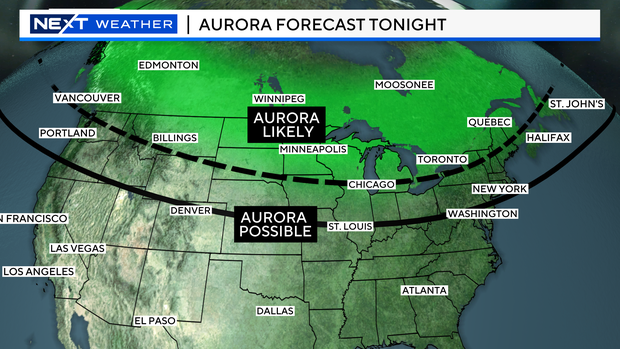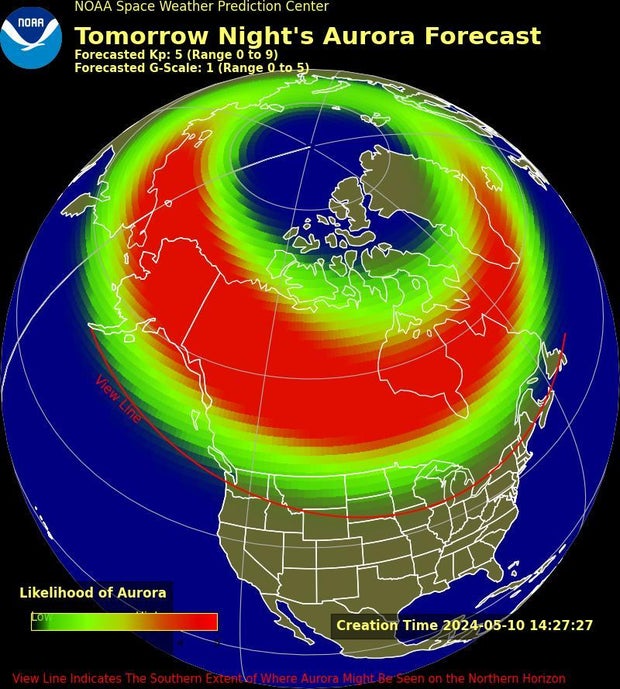Americans as far south as Alabama and Northern California were being treated to a show of the northern lights this weekend from a powerful geomagnetic storm which reached Earth, officials said. If the weather conditions are right, people in wider areas on the map could look up and see the aurora borealis.
The storm prompted government forecasters to warn of potential disruptions to communications systems, the power grid and satellite operations, but it also put on a fantastic light display in the night sky Friday.
“The aurora is when we get energized particles that have left the sun in more quantities than usual, and they interact with Earth’s magnetic barrier,” Shawn Dahl, senior space weather forecaster for the National Oceanic and Atmospheric Administration, explained to CBS News.
The geomagnetic storm reached Earth Friday evening as an “extreme” G5, according to the NOAA’s Space Weather Prediction Center. Geomagnetic storms are ranked from G1 to G5.
“This one is pretty large, It think it’s pretty extreme, we got to the G5, which is the highest in terms of strength,” said Dr. Nour Rawafi, an astrophysicist with the Johns Hopkins Applied Physics Laboratory.
It marks the first G5 geomagnetic storm to reach Earth since October 2003. A G5 is so large it can disrupt satellites we rely on for communications and GPS. Elon Musk’s Starlink satellites were reporting “degraded service.”
Dahl explains a G5 storm can potentially disrupt the GPS we use on our phones.
“It could, because most of our phones are single-frequency GPS systems,” Dahl said.
Experts say the aurora borealis will likely be viewable again Saturday night, with the best chance to see the northern lights between 10 p.m. and 2 a.m. Sunday.
Getty Images
“If you happen to be in an area where it’s dark and cloud free and relatively unpolluted by light, you may get to see a fairly impressive aurora display, and that’s really the gift from space weather, is the aurora,” Rob Steenburgh, a space scientist with the NOAA’s Space Weather Prediction Center, told reporters Friday morning.
Northern lights map for Friday night
A map from the center showed the aurora would be visible for much of the northern half of the U.S. Friday night. A red line on the map shows how far south the aurora forecast went.
Space Weather Prediction Center
The National Weather Service’s St. Louis office said people in the area should leave the city for the best possible chance to view the northern lights.
“Get away from city lights into a dark, rural surrounding and look north,” the office said on social media. “Aside from some clouds associated with a passing front, much of the time looks mostly clear.”
The prediction center notes on its website that people don’t need to be directly underneath the aurora to see it. Instead, it can be observed from as much as 620 miles away.
CBS News
The weather service’s office for the San Francisco Bay Area had been less optimistic when asked if there was a chance for a nighttime show there.
“Probably not, but I’ll still look up while walking my dog,” the office said. But the weather service turned out to be wrong, the northern lights were visible from the Bay Area.
Tayfun Coskun/Anadolu via Getty Images
Northern lights map for Saturday night
Friday night wasn’t the only opportunity for a northern lights show. The storm was expected to last through the weekend, and the prediction center released a forecast map for Saturday night.
Space Weather Prediction Center
Officials said people in the southern U.S. who can’t see the aurora with their naked eyes could still take some dazzling pictures with their phones.
“Cellphones are much better than our eyes at capturing light,” the Space Weather Prediction Center’s Brent Gordon told reporters Friday. “Just go out your back door and take a picture with a newer cellphone, and you’d be amazed at what you see in that picture versus what you see with your eyes.”
Stunning photos showed the vivid display of the northern lights over Europe and the U.K. after nightfall there on Friday.
Patrick Pleul/picture alliance via Getty Images
Andrew Matthews/PA Images via Getty Images
— Michael George contributed to this report.











